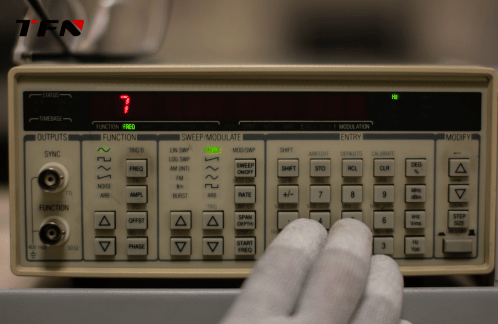Application of Microwave Signal Generators in Satellite Communications: Technological Innovation with TFN TG20A as the Core
Introduction
With the rapid development of global satellite communication technology, the demand for high-frequency bands and high-precision signals is growing. As the core equipment for satellite system research and development and testing, microwave signal generators have become a key tool to ensure communication quality with their wide-band coverage, high dynamic output and precise frequency control capabilities. This article will explore in depth how the TG20A microwave signal generator under the TFN brand can meet the stringent requirements of signal generation and testing in the field of satellite communications through technological innovation.
Technical Challenges of Satellite Communications and the Role of Signal Generators
High-frequency Band Requirements and Signal Stability
Modern satellite communication systems generally use high-frequency bands such as Ku (12-18GHz) and Ka (26.5-40GHz) to increase data transmission rate and capacity. However, high-frequency signals are easily interfered by factors such as atmospheric attenuation and multipath effects, requiring the signal source to have extremely low phase noise (such as -112dBc/Hz@10kHz, 10GHz) and ultra-wide frequency coverage to ensure signal stability in complex environments.
Dynamic range and power accuracy requirements
Satellite ground stations need to handle wide dynamic range scenarios from weak received signals (as low as -120dBm) to strong transmitted signals (up to +17dBm). Traditional equipment is difficult to balance the contradiction between low noise and high power output, while the large dynamic output range (-120dBm~+17dBm) and 0.1dB power resolution of TG20A provide precise control capabilities for simulating real link attenuation.

TFN TG20A Core Technical Advantages
9kHz-21GHz ultra-wide frequency coverage
TG20A supports 9kHz to 21GHz continuous wave output, covering mainstream satellite bands such as L, S, C, X, and Ku. Its frequency resolution of 0.001Hz can accurately generate carrier signals at specific frequencies to meet the needs of satellite modem calibration, multi-band compatibility testing, etc. For example, in the development of Ka-band satellite prototypes, TG20A can verify the anti-saturation characteristics of the front-end circuit through the 21GHz limit frequency.
-120dBm~+17dBm large dynamic power output
Satellite communication tests often need to simulate signal attenuation caused by long-distance transmission (such as as low as -120dBm) or near-field strong interference scenarios (such as +17dBm). The power dynamic range of TG20A supports stepless adjustment of the entire frequency band (1GHz to 40GHz), combined with -80dBc spurious suppression and -50dBc harmonic suppression to ensure the purity of the output signal and avoid false components interfering with the receiver sensitivity test.
High-precision frequency reference and phase noise performance
TG20A has a built-in reference source with an initial calibration accuracy of ±0.1ppm, and supports external 10MHz synchronization input, which can seamlessly access the atomic clock reference of the satellite system. Its phase noise is as low as -112dBc/Hz@10kHz at a 10GHz carrier, which significantly reduces signal jitter and is suitable for Doppler frequency shift simulation in high-speed mobile scenarios of low-orbit satellites (LEO).
Typical Application Scenarios of TG20A in Satellite Communications
Satellite payload performance verification
In satellite payload (such as transponder) testing, TG20A can generate QPSK/16APSK signals with modulation error (EVM<1%), combined with its pulse modulation function (minimum pulse width 50ns@100MHz), to verify the response speed and linearity of the payload in burst mode. In addition, the sweep mode (10ms step) can quickly traverse the entire frequency band to detect the spurious response in the payload band.
Ground station receiver sensitivity test
The ground station receiver needs to maintain a low bit error rate at the level of -120dBm. The 0.1dB power resolution of TG20A allows the output power to be reduced step by step to accurately determine the receiver threshold; at the same time, its low phase noise characteristics of -145dBc/Hz@1kHz (10MHz reference source) can prevent the local oscillator phase noise from masking the true receiving performance.
Anti-interference and multi-signal simulation
Through the multi-channel synchronization function of TG20A (external combiner is required), the main signal and interference signal (such as adjacent frequency interference and harmonic interference) can be generated simultaneously to test the anti-blocking ability of the receiver. For example, a -80dBc spurious signal is superimposed at the 10GHz main frequency to simulate the cross-interference of other satellites in the same frequency band.
Technical Comparison and Industry Competitiveness
Compared with similar equipment, the differentiated advantages of TG20A are reflected in:
1. Frequency switching speed of 300μs: supports real-time testing of LEO satellite fast switching beams;
2. Built-in 100MHz/10MHz reference output: simplifies the system clock synchronization architecture;
3. Compact design (360×360×89mm): suitable for space-constrained scenarios such as vehicle-mounted mobile stations.
Future Trends and Technological Evolution of TG20A
With the development of 6G satellite-ground integrated networks, signal generators need to support higher frequency bands (such as terahertz), more complex modulation (1024QAM) and AI-driven adaptive testing. TFN Laboratory has developed a 40GHz extension module based on the TG20A platform and integrated SCPI script automation functions to help satellite manufacturers accelerate standardized testing processes.
Conclusion
As a core test tool in the satellite communication industry chain, TFN TG20A microwave signal generator provides full-link verification capabilities for satellite system development with ultra-wide frequency band, high dynamic accuracy and excellent noise performance. In the future, with the diversification of satellite application scenarios, TG20A will continue to push the boundaries of high-frequency communication technology.
